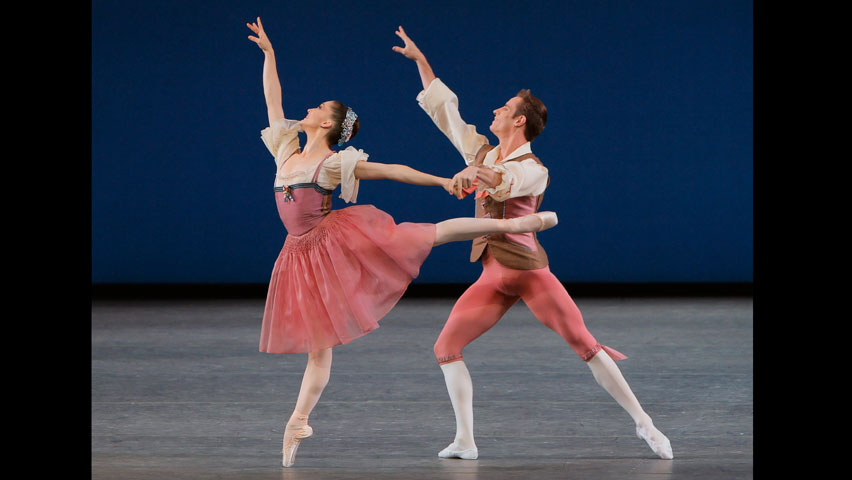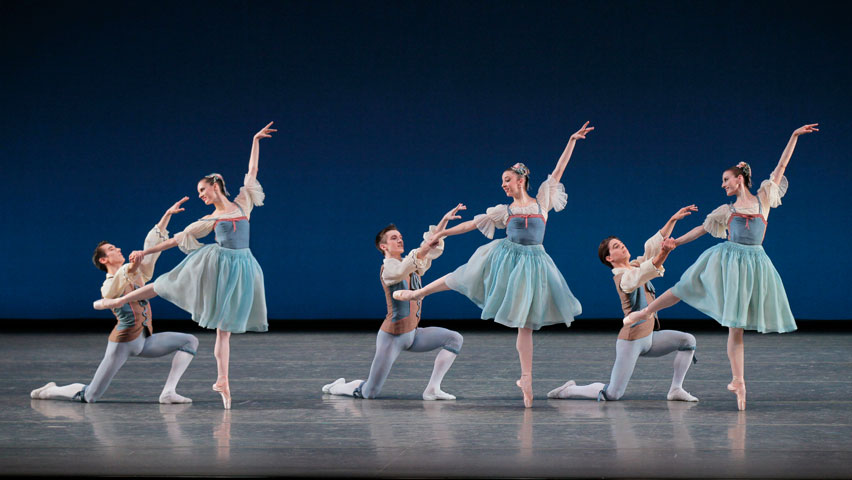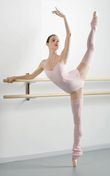Depictions of winemaking within ballet have not been too fruitful either. I still shudder when I think of the winemaking vignette from Mark Morris’s full-length Sylvia (which I saw performed by the San Francisco Ballet in New York some years ago). In this misguided scene the dancers stomp on grapes, drink the juice, and become instantly drunk—although I don’t know how they could: without undergoing fermentation that liquid would have been as alcoholically potent as a toddler’s juice box! The Grape Dance from Balanchine’s Donizetti Variations (1960) is a far better example, probably because it is more abstract. I doubt that many audience members even know that the lightning quick, four-girl dance which separates the lead couple’s pas de deux from their variations has such a title.
Structurally, the dance provides a much needed breather for the lead woman whose solo follows first. Although the dance is a trifle, Balanchine clearly had a lot of fun with this fast corps interlude. The Grape Dance begins as a string of four women proceed in a series of stage-skimming jumps in a circle around the stage. Our arms reach down and up alternately—as if we are picking grapes from vines, says ballet mistress Rosemary Dunleavy. We also perform lots of bourrées (tiny little steps on pointe) and chassées sur la pointe (literally “chasing” steps in French, like children’s skipping but entirely on our toes) which make us look like we are vigorously stomping grapes in our pointe shoes. The tempo for this dance is so fast that although we are doing classical, petit-allegro ballet steps we resemble peasants crushing grapes more than ballerinas. The challenge of the Grape Dance is trying to fully point one’s feet and jump as high as possible while still remaining on the music. It is so hard to fit all the steps in that I think none of us breathe for the entire two-minute entrance!
The Grape Dance is one of many jokes in Donizetti—one of Balanchine’s goofier concoctions overall. From the elaborate trumpet fanfare that opens the piece as the corps runs out and then poses in dead silence, to the toe-stubbing solo of a sneaky corps woman, to the men trying to snatch kisses from the female lead as she turns, it is really a very silly piece. It is—like Raymonda Variations—difficult, pure ballet danced with a sly wink. And as Raymonda is a send-up of the technically daunting solos that dot full-length story ballets, Donizetti is Balanchine’s slightly irreverent riff on the peasant chic and beaten jumps of Giselle and the Bournonville school.
Donizetti was originally called Variations from Don Sebastian because its music is culled from the second act of that opera. The music seems awfully upbeat considering that the opera is sometimes referred to as “a funeral in five acts,” but I suppose there is a lot of darkness in the music for the Slave Dance, which has always sounded like a cousin of The Godfather theme to me. The Slave Dance is an adagio for the six women and three men of the corps de ballet. In it, we shield our faces with our arms (heads tucked into bent elbows)—to register our resistance I suppose—quite like in the Arabian/Coffee solo in Balanchine’s Nutcracker.
We in the cast laugh that it does feel like slavery, for everyone except the woman who steals a quick solo to the trumpet music at the start of the dance must wait, frozen, in a deep lunge until the scene comes back to life after she stubs her toe. Then, much of the dance that ensues is made up of painful bourrées for the women—I happen to have the unlucky spot as the caboose of a chain of girls who must make a huge backwards circle around the stage entirely on pointe. The men are saddled with dead-weight lifts and painstakingly slow promenades. But the Slave Dance manages to be quite fun despite all the physical discomfort; and the entire ballet is really a lark to perform. By the time we get to the finale, with its silly bicycle bell instrumentation and its marathon of emboîté jumps (the ballet version of the can-can), it is hard not to grin despite our aerobic exhaustion.



 RSS Feed
RSS Feed